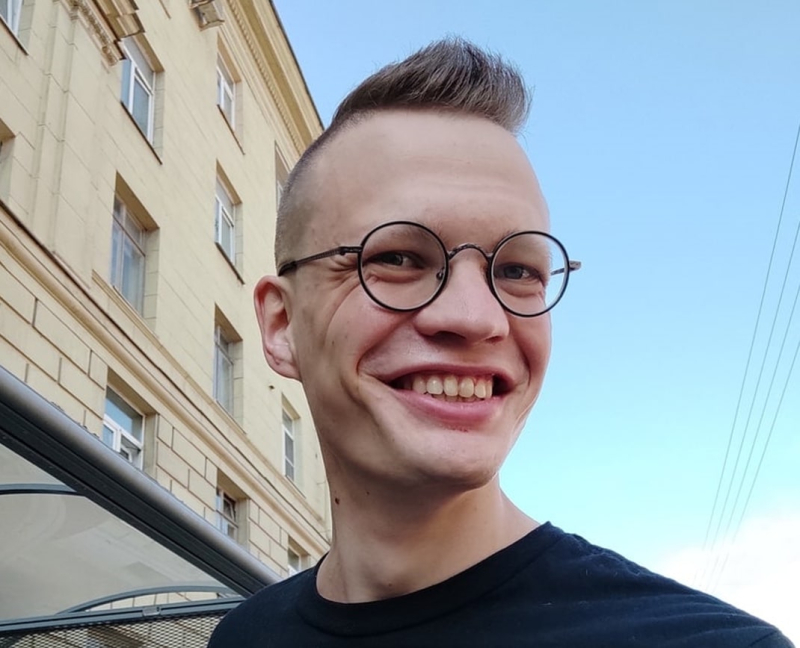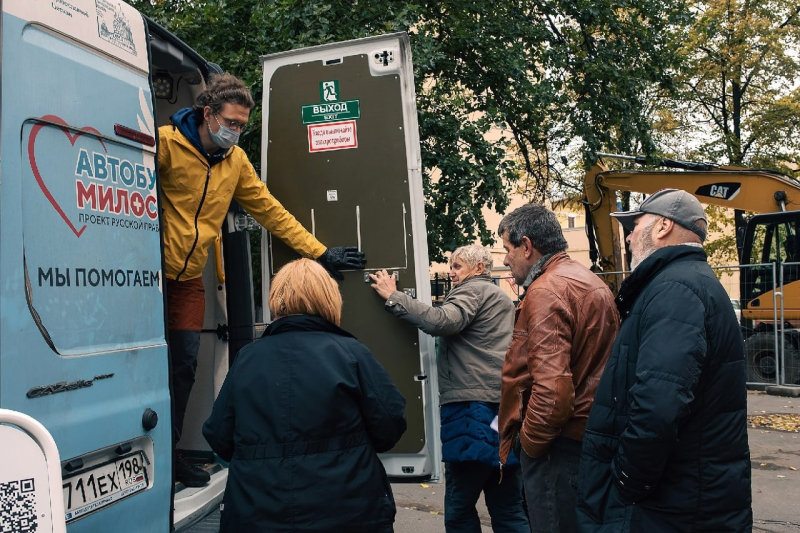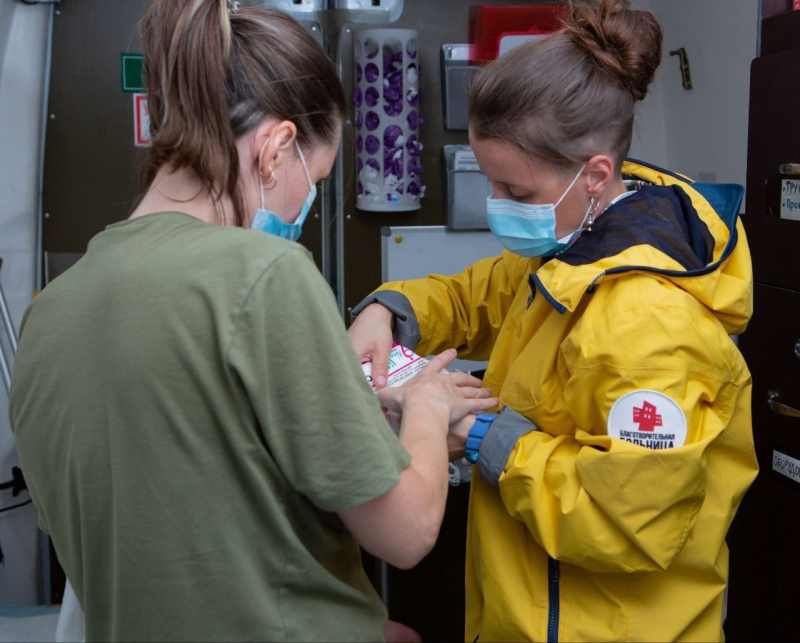How did Charity Hospital get its start?
I’d say it started with burnout. I had been a doctor for a long time, working with newborn children who were in critical condition. At some point, I realized I was running on autopilot and needed a change in activity.
In spring of 2018, I learned about the concept of street medicine. It means going out on the street to provide medical and social assistance to the homeless. I felt like doing some field work and helping those who find themselves in a vulnerable position and without access to basic medical services.
Why homeless people in particular?
It was just the easy choice from an organizational point of view. All you need to do is stock up on medicine and bandages, go outside, and find someone who needs help.
And how did you start doing that?
I visited various organizations that provide food and shelter to homeless people. Those who came there needed medical help but weren’t receiving it.
June 26, 2018 was the first time that we went out as a team. There were several medical specialists as well as social workers who had observed my work before. You could say this was the birthdate of Charity Hospital: we sat in a cafe, discussed our work, looked over photographs of wounds and discussed how best to treat them.
So it started as a volunteer project?
It did. In the first few years, none of us had a salary and we worked on pure enthusiasm. We received (and still do) medicine and other supplies from well-wishers. It was only last year that we registered as a non-profit, which allowed us to purchase medicine and pay wages to the staff. But a great deal of work is still done by volunteers who just want to help homeless people survive on the streets.
How many volunteers are involved today?
As of this moment, there are some 130 members in our chats. These are the people who go out on calls and work directly with the homeless. Then, there is the editorial team, who run our social media and photograph our activities.
In addition to the volunteers, there are several permanent employees: an administrator, an accountant, and several doctors who coordinate everyone’s work.

Sergey Ievkov. Photo courtesy of the subject
How do you manage such a large team?
I try to lead by personal example: I spend all day writing letters, giving interviews, and strategizing. It’s serious, intense work: you have to learn about PR, fundraising, and communicating with the government and businesses. Plus, you have to constantly talk to people. If we do something well, I tell my colleagues: look how great it is that we’ve been able to help others! The volunteers see that and it motivates them to go out in the field again.
It’s important to be transparent and easy to understand; to broadcast your values to the world. We need to talk about it on social media, to show people that we’re around and our work continues. If people see that our project does good, they’ll be ready to donate to the hospital, contribute bandages and drugs, or become volunteers themselves.
The project lives and grows. Our message is a humanitarian one: we believe that everyone has the right to basic medical assistance, no matter if they have a passport or a roof over their head. That’s why our project appeals to all alike: government workers, students, and many others.
Who makes up the bulk of your volunteers?
There are several key categories. The first are young medical specialists or students. They want to gain experience – learn how to bandage wounds, for instance – or learn more about illnesses that they’ve only seen in textbooks before.
Then there are the doctors who are tired of working at big hospitals. To them, Charity Hospital is a way to unwind: here, they can share their experience and meet people who are truly grateful for the help. Since our work is done on the street, we value evidence-based medicine and try to use only the most effective treatments.
Finally, there are those who aren’t medics by trade, but are interested in the field. There are, say, artists or IT specialists who come and work with us in order to learn more about medicine. I know a dozen people who volunteered with Charity Hospital before applying to medical college. To them, our project is a launchpad: first, they learn to provide first aid and then go on to become nurses and paramedics.
What is your working process like?
We work in several formats. First, there’s our mobile hospital – a specially modified van that we use to provide medical care. Six days a week, we drive it to various areas of the city and work in the field: the patients enter it like you would a doctor’s office. We bandage wounds, give out medicine, do eye tests and provide eyeglasses; sometimes we’ll bring crutches or, in wintertime, warm clothes. We can also take an HIV test or send those with substance addiction issues to get treatment. We collaborate with the city’s hospitals to provide free shots against the flu and COVID-19. In emergency cases, we’ll contact the ambulance services.
In addition to the mobile hospital, our organization partners with various homeless shelters, first and foremost the Order of Malta’s Russian Relief Service. They have two medical offices – a surgeon’s and a general practitioner’s. Twice a week, their staff provide check-ups and consultations, the same way as we do at the mobile hospital.

Volunteers of the Charity Hospital at work. Photo by Vitaly Kurdenko, courtesy of Sergey Ievkov
Who do you treat most often?
We don’t have the complete stats yet, but it’s not just homeless people, although they are among our patients. We also help people who live on the verge of homelessness in so-called kommunalkas (shared apartments, typically in neglected condition – Ed.). They come to our clinic and we offer them free food and the medication that they can’t afford themselves.
How many patients do you treat in one trip?
We’ve recently introduced a rule of 15 minutes per patient. This doesn’t mean that if an examination takes longer, we will ask the person to get out – it just means that our volunteers and clinicians try to stay within this timeframe. This way, we can help six to ten people in a two-hour trip. Some of them just need an HIV test or a pair of eyeglasses, which is a short visit, but others will come in for their first examination and they will need more time. We tell those who we couldn’t see on a particular day about our other locations or the state-funded first aid post for the homeless. In a month, we treat about 200 unique patients.
What can we do if we see a homeless person who needs help?
First of all, if you spot a homeless person, it’s already a big deal to show them kindness. If you see someone in need, drop by the nearest shop and get them some hot tea and some food.
If you want to do more, you can try talking to them. Sometimes, a person won’t open up to you and in this case, you should respect their boundaries – don’t try to force anything on them. Sometimes, they will have a specific request, like, for instance, a crutch, because their leg aches. You can offer them a flier with information about our Charity Hospital. However, if you see someone in an emergency, for instance, if they have pain in their chest, an open wound, trouble breathing, or alterations of consciousness – or maybe it is a woman about to give birth, or someone who has lost consciousness and is not answering to you – these are all reasons to call an ambulance. Answer their questions precisely and stay with the person in need until the car arrives.
Another thing: in winter, if you see someone lightly dressed and lying on the ground or not being able to get up, this is another reason to call an ambulance. This person can get all sorts of terrible freeze burns and injuries, so don’t hesitate to call for professional help.
If the person you saw can talk, listen to their requests. You can send them to us – just tell them where we will be going next (to find out, call us on our hotline) so that they can come to us themselves. And if they need to restore their ID or want to find a job, you can send them to Nochlezhka, the Order of Malta’s Russian Relief Service, or other similar organizations.

Volunteers of the Charity Hospital at work. Photo by Vitaly Kurdenko, courtesy of Sergey Ievkov
How can someone help you apart from volunteering?
They can donate drugs (that haven’t expired), bandages, or glasses: there is a whole list of things that we need. If you have a pair of glasses you don’t use (including sunglasses) or a case for them, you can bring them in. We will check their condition and offer them to a homeless person.
You can also support us financially. A small but regular donation is of great help because it allows us to do our regular trips to different areas of the city and conduct routine examinations of our patients.
Finally, if you are into sports, sign up as a volunteer and take part in our sports events, Bolnichka Goes or Bolnichka Runs, with our team.
How are you planning to collaborate with ITMO?
We want to draw public attention not only to the issue of caring for homeless people with vision problems, but also to how important it is to treat everyone with kindness. That’s why we would be happy to organize joint lectures with ITMO’s Center for Science Communication, where we would talk more about the scale of vision impairment problems and the UN’s global initiative to prevent blindness.
If you want to volunteer for the charity, fill in this form. You can also sign up to make regular donations to the project here. And if you print out this flier, you can offer it to the next homeless person you see to inform them about the project.
Written by Sergey Drugov





